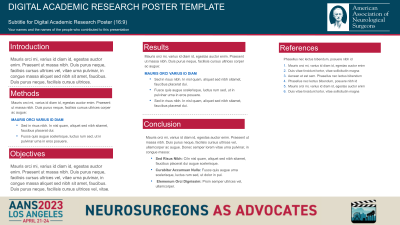Flow Diversion of Vertebrobasilar Aneurysms with the Pipeline Embolization Device
Friday, April 21, 2023


David C. Lauzier, n/a
Medical Student
Washington University School of Medicine
St. Louis, Missouri, United States
ePoster Presenter(s)
Introduction: Flow diversion of intracranial aneurysms with the pipeline embolization device has become a frequently employed treatment strategy for intracranial aneurysms in the past decade. Aneurysms of the vertebral artery and basilar artery are technically challenging to treat due to proximity of essential brainstem structures, but may be amenable to flow diversion with the pipeline embolization device.
Methods: Clinical and angiographic data were retrospectively obtained from the electronic medical record and aggregated in a dedicated neurointerventional database. Eligible patients were assessed for key clinical and angiographic outcomes. Degree of angiographic filling of aneurysms is reported using the O'Kelley-Marrotta grading scale.
Results: Twenty-six vertebral artery and basilar artery aneurysms in 26 patients were treated with the pipeline embolization device during the study period. Median age at treatment was 59 years (IQR 39-65) and 57.7% of patients were female (15/26). One patient had a single aneurysm that underwent two separate pipeline treatments. Median aneurysm size at largest dimension was 10.5 mm (IQR 7.0-19.0) Treated aneurysms were located in the following locations: 53.8% (14/26) in the vertebral artery, 19.2% (5/26) at the vertebrobasilar junction, and 26.9% (7/26) in the basilar trunk. Morpholgies were 53.8% (14/26) fusiform, 38.5% (10/26) saccular, and 7.7% (2/26) irregular. Angiographic follow-up was available for 80.8% (21/26) of aneurysms treated. Angiographic follow-up was available for 80.8% (21/26) of patients. At final angiographic follow-up, 61.9% (13/21) of aneurysms were completely occluded, 4.8% (1/21) of aneurysms only included an entry remnant, 28.6% (6/21) of aneurysms demonstrated subtotal filling, and 4.8% (1/21) of aneurysms demonstrated total filling. Ischemic complications were experienced by 15.4% (4/26) of patients and hemorrhagic complications were experienced by 1.5% (1/26) of patients.
Conclusion : Pipeline embolization of vertebrobasilar aneurysms demonstrated a 61.9% rate of complete occlusion. However, these aneurysms carry a risk for ischemic and hemorrhagic events. Further work is necessary in larger cohorts.
Methods: Clinical and angiographic data were retrospectively obtained from the electronic medical record and aggregated in a dedicated neurointerventional database. Eligible patients were assessed for key clinical and angiographic outcomes. Degree of angiographic filling of aneurysms is reported using the O'Kelley-Marrotta grading scale.
Results: Twenty-six vertebral artery and basilar artery aneurysms in 26 patients were treated with the pipeline embolization device during the study period. Median age at treatment was 59 years (IQR 39-65) and 57.7% of patients were female (15/26). One patient had a single aneurysm that underwent two separate pipeline treatments. Median aneurysm size at largest dimension was 10.5 mm (IQR 7.0-19.0) Treated aneurysms were located in the following locations: 53.8% (14/26) in the vertebral artery, 19.2% (5/26) at the vertebrobasilar junction, and 26.9% (7/26) in the basilar trunk. Morpholgies were 53.8% (14/26) fusiform, 38.5% (10/26) saccular, and 7.7% (2/26) irregular. Angiographic follow-up was available for 80.8% (21/26) of aneurysms treated. Angiographic follow-up was available for 80.8% (21/26) of patients. At final angiographic follow-up, 61.9% (13/21) of aneurysms were completely occluded, 4.8% (1/21) of aneurysms only included an entry remnant, 28.6% (6/21) of aneurysms demonstrated subtotal filling, and 4.8% (1/21) of aneurysms demonstrated total filling. Ischemic complications were experienced by 15.4% (4/26) of patients and hemorrhagic complications were experienced by 1.5% (1/26) of patients.
Conclusion : Pipeline embolization of vertebrobasilar aneurysms demonstrated a 61.9% rate of complete occlusion. However, these aneurysms carry a risk for ischemic and hemorrhagic events. Further work is necessary in larger cohorts.
